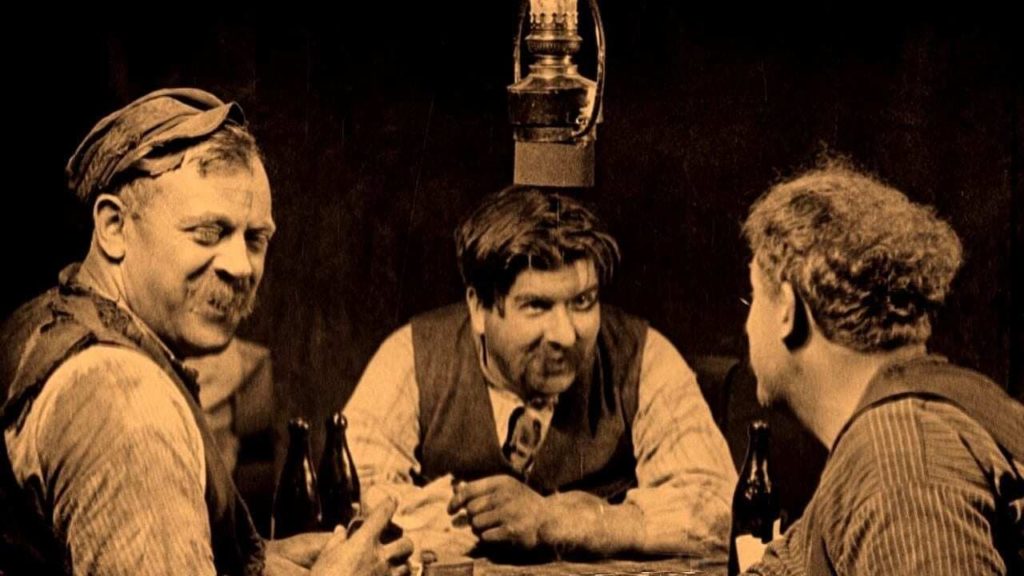I was recently watching some YouTube videos on Crash Course about film history with my three year old daughter. One of the videos described early innovations in film technique, including running film through the camera twice to create a ghostly shadow. I thought “huh, haven’t really seen too much of that before.” Little did I know that the next film in my tour through 1001 Films You Must See Before You Die would not only use this technique, but as its signature effect: The ghostly translucent shape of a dead man’s spirit and a semi-corporeal grim reaper.
The overall visual profile of this film is excellent. In addition to the double exposure technique, Phantom Carriage features the most powerful use of color-tinted B&W film I’ve seen yet: melancholic yellows and the haunting blue of the afterlife. There’s a gloomy austerity to the supernatural here, far removed from the expressionistic production of The Cabinet of Dr. Caligari. The film is well-preserved, and there’s a gritty texture to the cinematography that complements the film’s story.
Another strength of this film — its aspect that foreshadows later art films — is psychological complexity. The American epics of the 1910s and early 1920s I’ve seen so far were largely melodramas with flat, typed characters. Here, there’s shading to the characters: a fallen husband who continually wastes shots at redemption; a naive social worker whose tender heart proves her undoing; a tormented wife torn between moving on and forgiving her troubled husband.
Of course we must acknowledge that the heart of the story is fairly didactic and prudish: The Phantom Carriage is a temperance film at its core. This is a major knock on its watchability a century later, especially with a runtime that eclipses 100 minutes: It’s built around a whole lot of finger-wagging and cynical preachiness with not quite enough character color to make up for it.
The acting is remarkable. Victor Sjostrom both directs and stars, capturing all the grimy depravity but inner humanity required of the lead. The film also features great turns from Hilda Borgstrom as his wife and Astrid Holm as Sister Edit. The cast is excellent from top to bottom — all showing quite a bit of restraint for the era where overacting was norm.

The film’s story is an extra-dark Christmas Carol twist: Drunkard Peter Holm dies on the streets as the New Year tolls midnight, and he encounters Death himself. Being the first death of the new year, Holm must drive the “Phantom Carriage” in a Charon-esque responsibility for the next twelve months. Holm proceeds to revisit important moments of his life and witness how he squandered every chance for a brighter future. He carelessly passed his tuberculosis to his wife, his kids, and even kind social worker Sister Edit, who is in love with him and now on her deathbed from the affliction.
There’s more to it than personal tragedy, though. The film makes clear that Holm is just the next in line to inherit society’s sins, and that the cycle will continue. The film has an oppressively bleak worldview that grows like a stone in your gut as you watch. The tenuous, happy ending of death undone that it arrives at is cheap, as if Sjostrom feared his audience just couldn’t bear the all-out tragedy his story was leading to. I’m marking the film down one notch just for this.

The Phantom Carriage carries with it tremendous gravity for an early 20s film, and cast a long influence on European film. Its image of hooded death with a sickle is perhaps the most lasting single takeaway: it is haunting and eternal and became one of our standard depictions of the death personified. But as a whole it is satisfying and chilling, astonishingly crafted to deliver its icy tone and dark story. Its 105 minutes drag on quite slowly, especially given how humorless it is. And the ending, as mentioned, feels a bit like a cop-out. Formally and tonally, this is an early masterpiece of the form, but unlike some of the horror works of the era, I think it’s better left for film historians or early cinema enthusiasts.
(I’m attempting to watch 1001 Films to See Before Your Die in chronological order. This is film number 11. Up next is The Smiling Madame Beudet.)
Is It Good?
Good (5/8)
A few words on "Is It Good?" ratings for early cinema.
Dan is the founder and head critic of The Goods. Follow Dan on Letterboxd. Join the Discord for updates and discussion.

